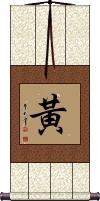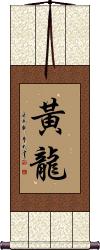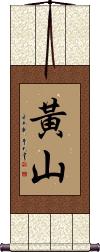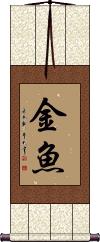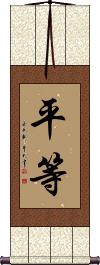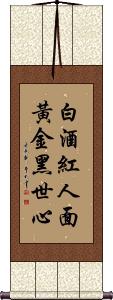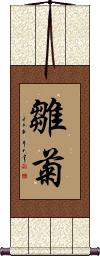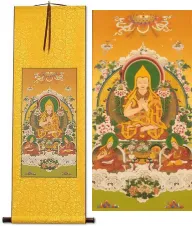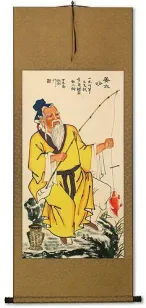Many custom options...
And formats...

Yellow in Chinese / Japanese...
Buy a Yellow calligraphy wall scroll here!
Personalize your custom “Yellow” project by clicking the button next to your favorite “Yellow” title below...
1. Yellow
3. Huang Shan / Yellow Mountain
4. Goldfish
5. Shichi-Kyu
6. Equality
7. Just as Liquor Turns a Face Red, Gold Turns a Heart Black
8. Daisy
Yellow
Yellow Color
黃 is the single character for the color yellow in Chinese.
This can be a Chinese surname Huang or a Korean surname Hwang.
In China, yellow is traditionally the color of the emperor. In fact, there was a time when only the emperor could wear yellow clothing or own yellow pet fish.
Note: Goldfish were bred originally in China for the emperor. When the perfect yellow fish was bred, all but the emperor were banned from owning any. Thus a more orange-colored goldfish dominated the market.
Notes: 黃 is not a common selection for a wall scroll. In certain contexts in China, yellow can refer to pornography or vice.
![]() This character is written with a slight variation in Simplified Chinese and modern Japanese. Click on the image to the right if you want this alternate version.
This character is written with a slight variation in Simplified Chinese and modern Japanese. Click on the image to the right if you want this alternate version.
Yellow Dragon
黃龍 is a sophisticated or scholarly way to say “Yellow Dragon.” 黃龍 is the title you'd expect in ancient Chinese literature.
The first character means yellow.
The second character means dragon.
The Yellow Dragon represents a king that favorably hears all petitions of his subjects.
Note: This title can be the name of Huanglong county in Yan’an, located in Shaanxi province of China.
Huang Shan / Yellow Mountain
Goldfish
金魚 is the title for goldfish in Chinese and Japanese.
There was a time in ancient China when only the Emperor could possess the actual yellow-gold colored fish. This is why alternate coloration such as orange, black, red, and white was bred. Many believe this is why colors other than yellow-gold are more common for “goldfish” in pet shops today.
Shichi-Kyu
七級 or Shichi-Kyu/Shichikyu is the 7th Kyu or 7th Rank before black belt in many Japanese martial arts ranking schemes.
In some cases this is a yellow belt with two stripes, other schools designate this with a blue belt.
In Chinese, this can mean seven floors - like a seven-floor pagoda.
Equality
In Chinese, 平等 is the word that describes equality among all humans.
Yes, this is equality that means equality no matter of religion, whether you are rich or poor, gay or straight, black white or yellow.
In Japanese and Korean, this can be defined as equality, impartiality, and evenness (basically the same as the Chinese meaning).
Just as Liquor Turns a Face Red, Gold Turns a Heart Black
白酒紅人面黃金黑世心 literally says: [Just as] white liquor makes people's faces turn red, [So] yellow gold makes people's hearts turn black.
This is a warning about the nature of greed. The suggestion is that one who lusts for gold and riches will eventually have a black heart (or become a heartless greedy bastard). As a wall scroll, this is a reminder and warning to keep yourself from following the greedy path.
Daisy
The yellow flower
雛菊 is how they write “daisy” in Chinese and Japanese.
This is a good choice if you love daisies, or your name is Daisy. If you translated it directly, this means “chick flower” (as in baby chickens) or “baby chrysanthemum.” Of course, when an Asian person reads this, they just think “daisy.”
If you're into botany, this title represents “Bellis Perennis.”
In Japanese, this can be the female given name, Hinagiku.
This in-stock artwork might be what you are looking for, and ships right away...
Gallery Price: $63.00
Your Price: $35.00
Gallery Price: $72.00
Your Price: $39.88
These search terms might be related to Yellow:
50th Golden Wedding Anniversary
Confucius: Golden Rule / Ethic of Reciprocity
Fair / Impartial
Golden Dragon
Golden Rule
Golden/Metal Dog
Golden/Metal Dragon
Golden/Metal Goat/Sheep
Golden/Metal Horse
Golden/Metal Monkey
Golden/Metal Ox/Bull
Golden/Metal Pig/Boar
Golden/Metal Rabbit
Golden/Metal Rat
Golden/Metal Rooster
Golden/Metal Snake
Golden/Metal Tiger
Home of the Auspicious Golden Dragon
Impartial and Fair to the Brotherhood and Sisterhood of the World
The following table may be helpful for those studying Chinese or Japanese...
| Title | Characters | Romaji (Romanized Japanese) | Various forms of Romanized Chinese | |
| Yellow | 黃 黄 | hon / kou / hon / ko | huáng / huang2 / huang | |
| Yellow Dragon | 黃龍 黄龙 | huáng lóng huang2 long2 huang long huanglong | huang lung huanglung |
|
| Huang Shan Yellow Mountain | 黃山 黄山 | huáng shān huang2 shan1 huang shan huangshan | ||
| Goldfish | 金魚 金鱼 | kin gyo / kingyo | jīn yú / jin1 yu2 / jin yu / jinyu | chin yü / chinyü |
| Shichi-Kyu | 七級 七级 | shichi kyu / shichikyu | qī jí / qi1 ji2 / qi ji / qiji | ch`i chi / chichi / chi chi |
| Equality | 平等 | byou dou / byoudou / byo do | píng děng ping2 deng3 ping deng pingdeng | p`ing teng pingteng ping teng |
| Just as Liquor Turns a Face Red, Gold Turns a Heart Black | 白酒紅人面黃金黑世心 白酒红人面黄金黑世心 | bái jiǔ hóng rén miàn huáng jīn hēi shì xīn bai2 jiu3 hong2 ren2 mian4 huang2 jin1 hei1 shi4 xin1 bai jiu hong ren mian huang jin hei shi xin | pai chiu hung jen mien huang chin hei shih hsin | |
| Daisy | 雛菊 雏菊 | hinagiku | chú jú / chu2 ju2 / chu ju / chuju | ch`u chü / chuchü / chu chü |
| In some entries above you will see that characters have different versions above and below a line. In these cases, the characters above the line are Traditional Chinese, while the ones below are Simplified Chinese. | ||||
Successful Chinese Character and Japanese Kanji calligraphy searches within the last few hours...
